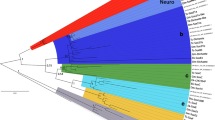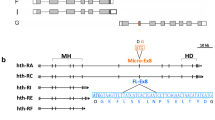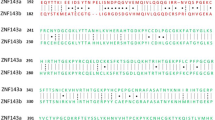Abstract
The homeotic gene Ultrabithorax encodes a family of six homeoproteins translated from alternatively spliced mRNAs. The structures of these UBX isoforms have been conserved among anciently diverged Drosoph-ila species and functional distinctions between some isoforms have been reported that suggest subtle but important roles in Ubx action. We present a detailed analysis of the expression patterns of Ubx mRNAs and proteins during embryogenesis, using isoform-specific monoclonal antibodies and synthetic oligonucleotide probes. These patterns are remarkably complex, each mRNA and corresponding protein isoform being expressed in a partially overlapping but distinct stage and tissue-specific pattern. The complexity is greatest in the central nervous system, where different isoforms predominate during successive developmental stages and where their relative proportions differ from one metamere to another and even among individual neurons within a given metamere. The distributions of UBX isoforms are consistent with those functional distinctions that have been described; they also suggest that different isoforms may be specialized or optimized to control different aspects of central nervous system development. The close correspondence between the mRNA and protein patterns indicates that the mRNAs do not differ strongly in translatability, despite the abundance of rare codons in the optional exons. There is a delay between the detection of particular splicing events in the nucleus and the detection of the 3′ end of the message or the appearance of the corresponding mRNAs and proteins in the cytoplasm. This delay is consistent with the size of the Ubx introns and indicates a cotranscriptional mechanism of splicing.
Similar content being viewed by others
References
Andrew DJ, Scott MP (1992) Downstream of the homeotic genes. New Biologist 4:5–15
Artero RD, Akam M, Pérez-Alonso M (1992) Oligonucleotide probes detect splicing variants in situ in Drosophilaembryos. Nucleic Acids Res 20:5687–5690
Beachy PA, Helfand SL, Hogness DS (1985) Segmental distribution of bithorax complex proteins during Drosophila development. Nature 313:545–551
Bermingham JR, Scott MP (1988) Developmentally regulated alternative splicing of transcripts from the Drosophila homeotic gene Antennapedia can produce four different proteins. EMBO J 7:3211–3222
Bienz M, Tremml G (1988) Domain of Ultrabithorax expression in Drosophila visceral mesoderm from autoregulation and exclusion. Nature 333:576–578
Bomze HM, López AJ (1994) Evolutionary conservation of the structure and expression of alternatively spliced Ultrabithorax isoforms from Drosophila. Genetics 136:965–977
Botas J (1993) Control of morphogenesis and differentiation by HOM/Hox genes. Curr Opin Cell Biol 5:1015–1022
Busturia A, Vernos I, Macias A, Casanova J, Morata G (1990) Different forms of Ultrabithorax proteins generated by alternative splicing are functionally equivalent. EMBO J 9:3551–3555
Campos-Ortega JA, Hartenstein VA (1985) The embryonic development of Drosophila melanogaster. Springer, Berlin Heidelberg New York
Chan S-K, Jaffe L, Capovilla M, Botas J, Mann RS (1994) The DNA binding specificity of Ultrabithorax is modulated by cooperative interactions with Extradenticle, another homeoprotein. Cell 78:603–615
Cribbs DL, Pultz MA, Johnson D, Mazzulla M, Kaufman TC (1992) Structural complexity and evolutionary conservation of the Drosophila homeotic gene proboscipedia. EMBO J 11:1437–1449
Duncan I (1987) The bithorax complex. Annu Rev Genet 21:285–319
Ekker SC, von Kessler DP, Beachy PA (1992) Differential sequence recognition is a determinant of specificity in homeotic gene action. EMBO J 11:4059–4072
Ghysen A, Jan LY, Jan YN (1985) Segmental determination in the Drosophila central nervous system. Cell 40:943–948
Hartenstein V (1987) The influence of segmental compartmentalisation on the development of the larval peripheral nervous system of Drosophila melanogaster. Roux's Arch Dev Biol 196:101–112
Hayashi S, Scott MP (1990) What determines the specificity of action of Drosophila homeodomain proteins? Cell 63:883–894
Heuer JG, Kaufman TC (1992) Homeotic genes have specific functional roles in the establishment of the Drosophila embryonic peripheral nervous system. Development 115:35–47
Hooper JE (1986) Homeotic gene function in the muscles of Drosophila larvae. EMBO J 5:2321–2329
Immerglück K, Larwrence PA, Bienz M (1990) Induction across germ layers in Drosophila mediated by a genetic cascade. Cell 62:261–268
Irvine KD, Helfand SL, Hogness DS (1991) The large upstream control region of the Drosophila homeotic gene Ultrabithorax. Development 111:407–424
Kaufman TC, Seeger MA, Olsen G (1990) The molecular and genetic organization of the Antennapedia complex of Drosophila melanogaster. Adv Genet 27:309–361
Kornfeld K, Saint RB, Beachy PA, Harte PJ, Peattie DA, Hogness DS (1989) Structure and expression of a family of Ultrabithorax mRNAs generated by alternative splicing and polyadenylation in Drosophila. Genes Dev 3:243–258
Kuziora MA (1993) Abdominal-B protein isoforms exhibit distinct cuticular transformations and regulatory activities when ectopically expressed in Drosophila embryos. Mech Dev 42:125–138
Lamka ML, Boulet AM, Sakonju S (1992) Ectopic expression of UBX and ABD-B proteins during Drosophila embryogenesis: competition, not a functional hierarchy, explain phenotypic suppression. Development 116:841–854
Lewis EB (1978) A gene complex controlling segmentation in Drosophila. Nature 276:565–570
López AJ (1995) Developmental role of transcription factor isoforms generated by alternative splicing. Dev Biol (in press)
López AJ, Hogness DS (1991) Immunochemical dissection of the Ultrabithorax homeoprotein family in Drosophila melanogaster. Proc Natl Acad Sci USA 88:9924–9928
Mann RS, Hogness DS (1990) Functional dissection of Ultrabithorax proteins in D. melanogaster. Cell 60:597–610
McGinnis W, Krumlauf R (1992) Homeobox genes and axial patterning. Cell 68:283–302
Merrill P, Sweeton D, Wieschaus E (1988) Requirements for autosomal gene activity during precellular stages of Drosophila melanogaster. Developement 104:495–509
Mlodzik M, Fjose A, Gehring WJ (1988) Molecular structure and pattern of expression of a homeobox gene from the labial region of the Antennapedia complex. EMBO J 7:2569–2578
O'Connor MB, Binari R, Perkins LA, Bender W (1988) Alternative products from the Ultrabithorax domain of the bithorax complex. EMBO J 7:435–445
Peifer M, Wieschaus E (1990) Mutations in the Drosophila gene extradenticle affect the way specific homeodomain proteins regulate segmental identity. Genes Dev 4:1209–1223
Peifer M, Karch F, Bender W (1987) The bithorax complex control of segmental identity. Genes Dev 1:891–898
Rauskolb C, Peifer M, Wieschaus E (1993) extradenticle, a regulator of homeotic gene activity, is a homolog of the homeobox-containing human proto-oncogene pbxl. Cell 74:1101–1112
Reuter R, Panganiban GEF, Hoffmann FM, Scott MP (1990) Homeotic genes regulate the spatial expression of putative growth factors in the visceral mesoderm of Drosophila embryos. Development 110:1031–1040
Scott MP, Tamkun JW, Hartzell GW (1989) The structure and function of the homeodomain. Biochim Biophys Acta 989:25–48
Shermoen AW, O'Farrell PH (1991) Progression of the cell cycle through mitosis leads to abortion of nascent transcripts. Cell 67:303–310
Stroeher VL, Jorgensen EM, Garber RL (1986) Multiple transcripts from the Antennapedia gene of Drosophila melanogaster. Mol Cell Biol 6:4667–4675
Subramaniam V, Bomze HM, López AJ (1994) Functional differences between Ultrabithorax protein isoforms in Drosophila melanogaster: evidence from elimination, substitution, and ectopic expression of specific isoforms. Genetics 136:979–991
Tautz D, Pfeiffle C (1989) A non-radioactive method for localization of specific RNAs in Drosophila embryos reveals translational control of the segmentation gene hunchback. Chromosome 98:81–85
Teugels E, Ghysen A (1985) Domains of action of bithorax genes in Drosophila central nervous system. Nature 314:558–561
Thummel CS, Burtis KC, Hogness DS (1990) Spatial and temporal patterns of E74 transcription during Drosophila development. Cell 61:101–111
van Dijk MA, Murre C (1994) Extradenticle raises the DNA binding specificity of homeotic selector gene products. Cell 78:617–624
Weinzierl R, Axton JM, Ghysen A, Akam M (1987) Ultrabithorax mutations in constant and variable regions of the protein coding sequence. Genes Dev 1:386–397
White RAH, Wilcox M (1985) Distribution of Ultrabithorax proteins in Drosophila. EMBO J 4:2035–2043
Author information
Authors and Affiliations
Rights and permissions
About this article
Cite this article
López, A.J., Artero, R.D. & Pérez-Alonso, M. Stage, tissue, and cell specific distribution of alternative Ultrabithorax mRNAs and protein isoforms in the Drosophila embryo. Roux's Arch Dev Biol 205, 450–459 (1996). https://doi.org/10.1007/BF00377226
Received:
Accepted:
Issue Date:
DOI: https://doi.org/10.1007/BF00377226




